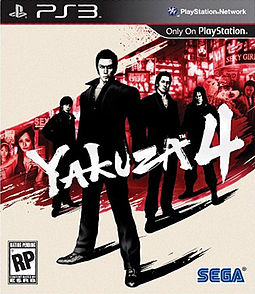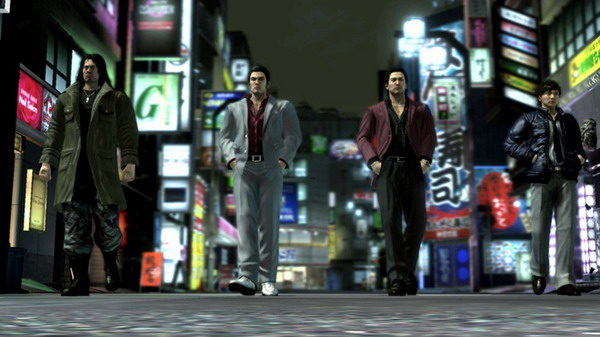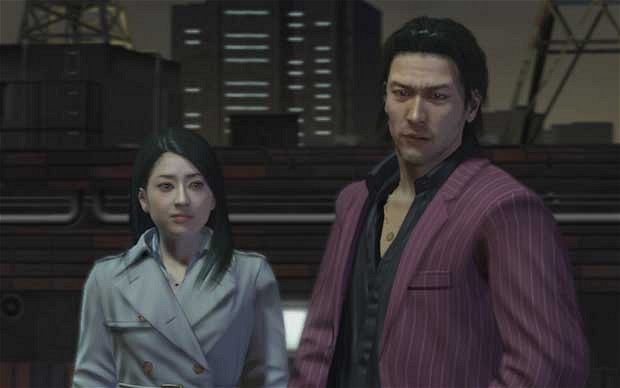This post has not been edited by the GamesBeat staff. Opinions by GamesBeat community writers do not necessarily reflect those of the staff.
It has always bothered me that Yakuza 3 and Yakuza 4 were both released with little fanfare to a mostly indifferent gaming community. That’s not to say that they weren’t adequately covered or reviewed, both games have scored relatively well on Metacritic after all, but there has been a decided lack of conversation about these games after their release.
I’m hoping to remedy that by taking an in-depth look at Yakuza 4. I won’t be reviewing the game in the traditional sense, since there are dozens of those already. Instead, I’m going to take a more comprehensive and focused look at the game, touching on the aspects of the game that I’d like other games to emulate.
A couple of caveats:
1) I consider the Yakuza games to be RPGs rather than open world sandbox games.
2) There will be broad spoilers in order to address the game in more than simple platitudes.
Location, location, location
Let’s start off with a simple one. The mainline Yakuza games stand out because they are set in Kamurocho, a fictionalized re-imagining of the glitzy entertainment district of Tokyo known as Kubukicho.
The real “Kamurocho”
As one of the few RPGs set in the “real” world, the player is immediately grounded in a relatable reality. Even if you don’t know a thing about Japan, you’ll still feel comfortable in Kamurocho because of the assumptions about the real world that you bring into the game. For example, you would it take for granted that body armor protects you from bullets or that sake will get you drunk. The game doesn’t need to teach you about the effects of a specific potion or the properties of a particular type of armor.
The setting also grounds the story, because the player expects some sense of verisimilitude when walking through the Tokyo streets. When characters die, they die – you don’t have a mage with you that can cast a resurrection spell. Suddenly a combat system that some might consider to be a mundane brawler becomes as exciting as a combat system that features giant swords or laser guns because anyone can imagine how painful it would be to be thrown head-first into a brick wall.
It would be remiss of me to ignore the Grand Theft Auto games, even if they aren’t RPGs, but all that really needs to be said is that the Yakuza games aim to be more faithful to reality than the GTA games. The Yakuza games aren’t trying to satirically represent violence in Japan, and so at no point will you walk through Kamurocho killing civilians or police officers. That’s not to say that Yakuza isn’t free of its own goofiness – every few moments, someone will try to mug you – but it’s a far cry from the extremely violent and perhaps sociopathic reality found in the GTA franchise.
A story that deserves to be rated “M”
Perhaps the strongest aspect of the Yakuza games has always been their stories. It would be disingenuous for me to say that the games are devoid of some of the strange plots and plot twists that are prevalent in JRPGs (and Japanese popular culture as whole), but the payoff for suffering the whiplash of a dozen surprising betrayals are stories that are mature and written for adults.
Indeed, I’ve always found it ironic that while RPGs are held up as the genre of games that have the strongest stories, most RPG stories are ultimately forgettable genre fiction that would barely stand up against the latest SyFy Original film. These are games that demand 30-100 hours of your attention for a story that serves only as an excuse to perform a series of fetch quests.
The Yakuza games feature stories that serve a greater purpose than to provide context for gameplay. Ranging from very broad themes such as family and honour to very specific themes like the American “colonization” of Okinawa, Yakuza has always tried to explore a wide range of ideas that tries to create a level of discourse not found in the typical RPG story.
Saejima, Kazuma, Akiyama and Tanimura. Each character explores a different theme
Yakuza 4divides the game up into four very specific themes and issues that are relevant not only to its native Japanese audience, but to wider audience as well.
- Akiyama’s story explores the issue of class and class mobility in Japan. There’s a tension between his natural ability as a banker to amass millions of dollars and the social pressures that conspire to strip away his personal fortune. As someone who doesn’t believe in the hierarchical nature of class, Akiyama is perfectly willing to subvert the system by giving interest free loans to anyone who can prove their self-worth as productive members of society. For Akiyama, wealth isn’t something you are born into; it is something you earn.
- Saejima’s story delves headfirst into the issue of family, both in terms of his relationship with his biological sister and in terms of his relationship with his adopted family, the Tojo clan. Not only is he torn between serving the Tojo clan and protecting his sister, his loyalty to both families is manipulated by outside forces, leading to the tragic circumstances at the end of the game. Yet, despite the suffering filial piety brings him, Saejima remains forever faithful to the Tojo clan.
- Tanimura’s story addresses the issue of race. Race and racism has always been an issue that has cropped up in the Yakuza games: Korean gangs were an integral part of Yakuza 2 and Yakuza 3 introduced Chinese gangs. But Tanimura’s story deals with race within Japan. As such, Tanimura’s chapter begins by introducing the player to a secret section of Kamurocho that only foreigners (Chinese, Korean, Thai, Vietnamnese, etc) are allowed into. We find out that he goes out of his way to protect a community that is largely invisible to the Japanese, from children orphaned by the deportation of their parents to women who are sexually abused by their Japanese employers and pimps.
- Kazuma returns, and as always, his story touches on the issue of duty and obligation. In Yakuza 3, Kazuma retired from the Tojo clan to run an orphanage in Okinawa. And while he gets pulled back into the business, at the end of the Yakuza 3 it is clear that he is happy to live out his life in peace. Of course, he becomes embroiled in yet another grand conspiracy involving the Tojo clan and is forced to return to Tokyo yet again. It becomes clear to Kazuma that, as much as he wants to leave the life of a yakuza behind, he is the only one that is capable of bearing the burden of running such a large organization.
Of course, there’s much more to Yakuza 4 than those four themes, but that should give you a taste of what the game tries to say about contemporary Japanese life. The Yakuza games have always been mature, but not because of the bloody violence or random bouts of sexuality. No, they’re mature because they treat players like adults and don’t presume to talk down to them.
Side quests that matter
Perhaps the cardinal sin of many RPGs is that the side quests have very little bearing on the story. At their worst, they are procedurally generated and provide nothing more than busy work in exchange for experience points and some trash loot.
In Yakuza 4, the side quests are as important as the main storyline, providing meaningful character development for the game’s four protagonists. These aren’t the one-off companion quests found in BioWare games either; rather, they are multi-chapter arcs that develop naturally alongside each character’s main thread.
For example, Tanimura’s side quest chain leads to a revelation that ultimately explains why he would empathize with the exploited migrant labourers living in a Tokyo ghetto. Yes, he’s one of the few “good” cops in the game and it’s only natural to have him sympathize with a group of people who have been forgotten by the rest of society, but when the story chain resolves itself, Tanimura’s own identity is called into question.
It’s very clear that these quests are deliberately written and crafted, providing more than the economy/item/experience time sinks that is found in side quests in other games. You’re not completing these quests in order to get the Purple Sword of Swordery +10 – you’re doing them to find learn more about the four main characters.
Linearity is not a bad word
Perhaps the greatest complaint that many reviewers will have about an RPG – and perhaps games in general – is that they are “too linear”. Chris Kohler jokingly called Final Fantasy XIII a modern remake of Pac-Man, decrying the straight path that the game forced players to take for the majority of the game.
Now, the Yakuza games aren’t strictly linear per se. The claustrophobic linearity of a game like Final Fantasy XIII is mitigated by the open nature of Kamurocho. Rather, the Yakuza franchise’s linearity is found in its main storyline. Unlike popular, contemporary WRPGs, Yakuza eschews player choice and agency in its storytelling: You’re not pulling the right trigger to be evil or selecting options on a dialog wheel, nor are you selecting from a vast array of missions and finishing them in any order that you would like.
The trade off is simple: A strictly defined and linear narrative gives the writers and designers the ability to carefully craft a story and characters that appeal to the player in the tradition of stage plays or films, but the player loses the agency of being able to control the narrative.
I’m not necessarily arguing that dialog/story trees are inferior to a well written but linear narrative; all I want to suggest is that a game that guides you through specific narrative beats still has a place in 2011. Both Yakuza 3 and Yakuza 4 were able to manipulate me into being emotionally invested in the characters, much like a well produced television show or a film, and the payoff is that these were the only games in recent memory where I was genuinely moved to tears.
Femme fatales never bring good tidings…
Perhaps these are “cheap” or “easy” tears, a product of relying on 20th century storytelling techniques that have nothing to do with gameplay. But this “outdated” mode of manipulation gave me an emotional incentive to finish these games. Suddenly, I was more invested in the outcome of the story than I’ve ever been when playing a single player RPG – and certainly that’s what all game designers hope for when their game ends up in the hands of players.
Optional variety
Finally, let’s touch on the open world aspects of Kamurocho. Realizing that cutting content from Yakuza 3 was a big mistake, Sega rightly decided to localize as much as possible for Yakuza 4. As such, the amount of content found in Yakuza 4 is staggering: there’s a golf mini-game, a baseball mini-game, a bowling mini-game, a side-scrolling shooter, pachinko, pool, darts, mahjong, shogi, western and Japanese gambling games such as black jack and cee-lo, hostess dating, hostess training, MMA fighter training, and combat training. Quite frankly, it’s possible to spend dozens of hours playing the game without actually touching any of the narrative content.
But perhaps the most important part of this variety is that it is strictly optional. While you are encouraged to explore the game world and play some of these mini-games, you are never forced to do so. As such, the game never grinds to a halt just because you are unable to learn the rules of mahjong or hit a ball in the batting cage – the game almost always offers you a way to continue the game without playing these mini-games.
[embed:http://www.youtube.com/watch?v=csgcBcMUueU ]
Take a break at the batting cages
What this does is allow the player to control the pace of the game. If you want to simply experience the game’s main narrative, it’s possible to play the game without playing any of the mini-games or even the side quests. If you feel like you need a break from the combat or just want a breather from the story, you can easily find a diversion without having to look outside of the game.
It’s a perfect balance between being overwhelmed with choice and not having any choice at all. While this might be standard fare for an open world game like Grand Theft Auto or Saints Row, most RPGs simply don’t have this amount of variety. If you are not sold on and invested in the combat mechanics, the gameplay can become boring real fast.
Conclusions
For a game of such breadth and depth, there’s certainly a lot more that I could write about. But I wanted to cover these five points because I think they are the best parts of game design that Yakuza 4, and the Yakuza franchise as a whole, brings to the table. In many ways, the game is fairly old fashioned – it’s linear, relies on cutscenes, includes dozens of optional mini-games and has characters that are unambiguously good or evil – but it is these same qualities that makes the game standout in a genre that is almost as crowded as the first person shooter space.
RPGs can be so much more than vehicles for the standard science fiction or fantasy storylines that are so common these days. They can tell stories which are relatable and realistic, they can be deep without being pandering, and they can be exciting without simply repeating the same combat mechanics over and over again. In a year of Dragon Age 2 and The Elder Scrolls V: Skyrim, it’d be very easy to overlook Yakuza 4. But I hope I have made a case for why it is a game that is worth playing and why other game designers should pay attention to it.




